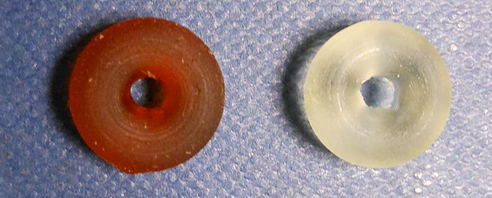 As 3D printing makes major impacts on the medical industry, it’s hard to find an area that’s not affected positively—and in most cases, substantially. From creating 3D printed models to help in diagnosing everything from tumors to pediatric cardiac issues and for assistance in complex surgeries to a wide array of 3D printed devices like implants and prosthetics, we hear of one inspiring story after another, and often with the notation that such a procedure or increased functionality would not have been possible without the seemingly miraculous new technology.
As 3D printing makes major impacts on the medical industry, it’s hard to find an area that’s not affected positively—and in most cases, substantially. From creating 3D printed models to help in diagnosing everything from tumors to pediatric cardiac issues and for assistance in complex surgeries to a wide array of 3D printed devices like implants and prosthetics, we hear of one inspiring story after another, and often with the notation that such a procedure or increased functionality would not have been possible without the seemingly miraculous new technology.
 The advent of 3D printed medication, however—even with all the obvious benefits such as incredible customization, affordability, and speed in production—is not without controversy. Like any items that can be fabricated but generally require regulation, with 3D printed guns being the best and even further extreme of an example, there is concern. These items that are meant to be used responsibly can also turn into a nightmarish form of criminal profitability on the black market, not to mention dangerous abuse.
The advent of 3D printed medication, however—even with all the obvious benefits such as incredible customization, affordability, and speed in production—is not without controversy. Like any items that can be fabricated but generally require regulation, with 3D printed guns being the best and even further extreme of an example, there is concern. These items that are meant to be used responsibly can also turn into a nightmarish form of criminal profitability on the black market, not to mention dangerous abuse.
3D printed pills, are however, becoming a growing trend that we report on often beginning with exploration into ways to make them to a range of materials to . With many researchers being inspired from the FDA approval and subsequent recent commercial availability of 3D printed SPRITAM pills for epilepsy, this new way of making medication is certainly becoming more accepted.
Now, in a project between researchers at University College London – School of Pharmacy and FabRx Ltd., they have 3D printed oral tablets using SLA technology. Their findings have been published recently in the International Journal of Pharmaceutics, outlined in the paper ‘Stereolithographic (SLA) 3D printing of oral modified-release dosage forms,’ authored by Jie Wang, Alvaro Goyanes, Simon Gaisford, and Abdul W. Basit.
The primary and initial objective of the project to begin with was to see if this was a sufficient way to make prescription drugs offering modified release. In a previous study, the outcome was not optimal as nearly half of the drugs—in this case 4-aminosalicylic acid (4-ASA)—deteriorated during the fabrication process, using an FDM printer.
According to the scientists, for this study they used polyethylene glycol diacrylate (PEGDA) as a monomer (a molecule that bonds to like molecules) and diphenyl phosphine oxide as the photo-initiator. With 4-aminosalicylic acid (4-ASA) and paracetamol (acetaminophen) selected as model drugs, they began 3D printing with a Form 1+ SLA 3D printer.
“Tablets were successfully printed and formulations with different properties were fabricated by adding polyethylene glycol 300 (PEG 300) to the printing solution,” stated the researchers, who found that with SLA technology they were indeed able to meet their goal.
They made the pills in a doughnut shape for testing purposes, reaching for challenge as the ‘torus design’ offers greater complexity and difficulty in 3D printing. None of the pills fell apart during the process, and due to the capabilities of the SLA 3D printer, medication can be mixed into the photopolymer before fabrications, which allows for it to be trapped inside. This is completed all in one step, which again adds to the benefits of 3D printing in not just the ability to customize, but also to manufacture speedily and affordably.
The researchers found substantial difference in the tools they used for this study, finding much greater success with the SLA printer, and rewarding them with another way to make pills that must incorporate drugs that are thermos-sensitive.
“In the future this technology could become a manufacturing technology for the elaboration of oral dosage forms, for industrial production or even for personalized dose,” concluded the researchers.
Discuss in the over at 3DPB.com.
[Source/Images: FabRx]Subscribe to Our Email Newsletter
Stay up-to-date on all the latest news from the 3D printing industry and receive information and offers from third party vendors.
You May Also Like
Printing Money Episode 17: Recent 3D Printing Deals, with Alex Kingsbury
Printing Money is back with Episode 17! Our host, NewCap Partners‘ Danny Piper, is joined by Alex Kingsbury for this episode, so you can prepare yourself for smart coverage laced...
Insights from Cantor Fitzgerald on AM’s Q1 2024 Landscape
A recent survey by Cantor Fitzgerald sheds light on the persistent challenges within the additive manufacturing (AM) industry in the first quarter of 2024. Based on responses from 38 industry...
3D Printing Financials: Xometry’s Scaling up and Strong Start to 2024
Xometry (Nasdaq: XMTR) kicked off 2024 with strong results, boosting its marketplace and technology to new heights. Both revenue and gross margin soared, fueled by an expanding global network of...
3D Printing Financials: Desktop Metal Targets Recovery Amid Net Losses and Revenue Downturn
Despite facing a decline in revenue and the persistent challenges of a tight economic climate, Desktop Metal (NYSE: DM) is making strides toward operational efficiency. The first quarter of 2024...


































